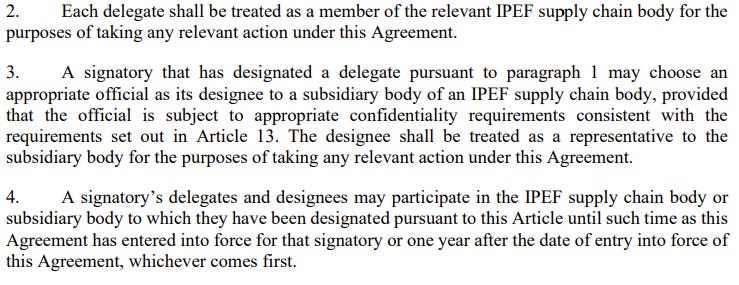IPEF: Pillar II (Supply Chain Agreement) halfway to entering into force?
Those following the Indo-Pacific Economic Framework for Prosperity (IPEF) may be interested in a few developments relating to the Pillar II Supply Chain Agreement over December/January. Whether IPEF will survive the upcoming US election remains to be seen, although the domestic US political maneuverings are certainly causing some officials in the region to ask whether the investments they’ve made in the IPEF negotiations to-date have been worth the effort.
The signing of IPEF’s Pillar II and conclusion of negotiations on Pillar III (Green Economy) and Pillar IV (Fair Economy) in November were key achievements for IPEF, but the US will still be keen to get actual implementation underway sooner rather than later to show IPEF has concrete benefits for the region and US interests. Similarly, IPEF participants have an interest in getting things in place prior to the US election totally taking over the US system.
In that context, Pillar II has made reasonable progress towards entry into force since November - having received three formal ratifications/acceptances by mid-January (Japan, the US and Singapore, in that order), and also Fijian media reporting that Fiji had ratified the agreement, although this is not yet showing up on State’s formal record (see below). Japan, the US and Singapore being at the front of the ratification pack makes sense and demonstrates their specific interest in seeing IPEF succeed. Fiji’s interest is also notable as the agreement’s only Pacific Island participant and being the smallest economy of the grouping.
The lack of a signature date for Vietnam in the above table from State is slightly strange. The announcements around 14 November stated that all 14 participants signed the agreement, so I’m assuming this is just an error (although one that has continued through multiple versions of the document). If Vietnam actually didn’t sign Pillar II in November (and has not done anything to correct this yet) that would not be a positive sign for its commitment to IPEF. But there haven’t been any suggestion of Vietnam stepping away to my knowledge (media reporting is in the opposite direction).
In any case, with three or four ratifications/acceptances we now are (at least) ‘halfway’ to the Supply Chain Agreement’s entry into force - which will be triggered 30 days after at least five signatories have ratified or accepted the agreement. How quickly a country ratifies an agreement is usually a function of (a) its interest in seeing the agreement implemented (and benefitting from it) and (b) how difficult its domestic processes are for ratification. So, for example, it likely would have been difficult for Australia to be in a position to ratify Pillar II as quickly as Japan given our specific parliamentary requirements which don’t have the level of flexibilities of the Japan system for certain kinds of international agreements.
Importantly, once there are the required five ratifications/acceptances, Article 22 of Pillar II allows all signatories to participate in Pillar II’s institutional bodies for up to a year, even if they haven’t ratified:
This arrangement is similar to provisional application of a treaty (e.g. in accordance with Article 25 of the VCLT). It means that even before being legally bound by all of Pillar II’s (admittedly largely aspirational) provisions, all of the signatories can still get the benefits from and contribute to what is really the most concrete part of Pillar II - the work of its three bodies: the Supply Chain Council, Labor Rights Advisory Board, and Crisis Response Network (noting that if Vietnam hasn’t actually signed the agreement it wouldn’t be able to benefit from this regime).
Putting this all together, it means real work under IPEF’s Pillar II could very well get underway before the US election hits (and elections elsewhere). This will hopefully help answer the question of how meaningful and useful the agreement is in practice. Even more than for usual trade agreements, implementation will be key to seeing if Pillar II has sufficient value-add to stick around past election cycles.1
You can also follow me on Twitter/X for more regular updates on IPEF ratifications if this of interest.






